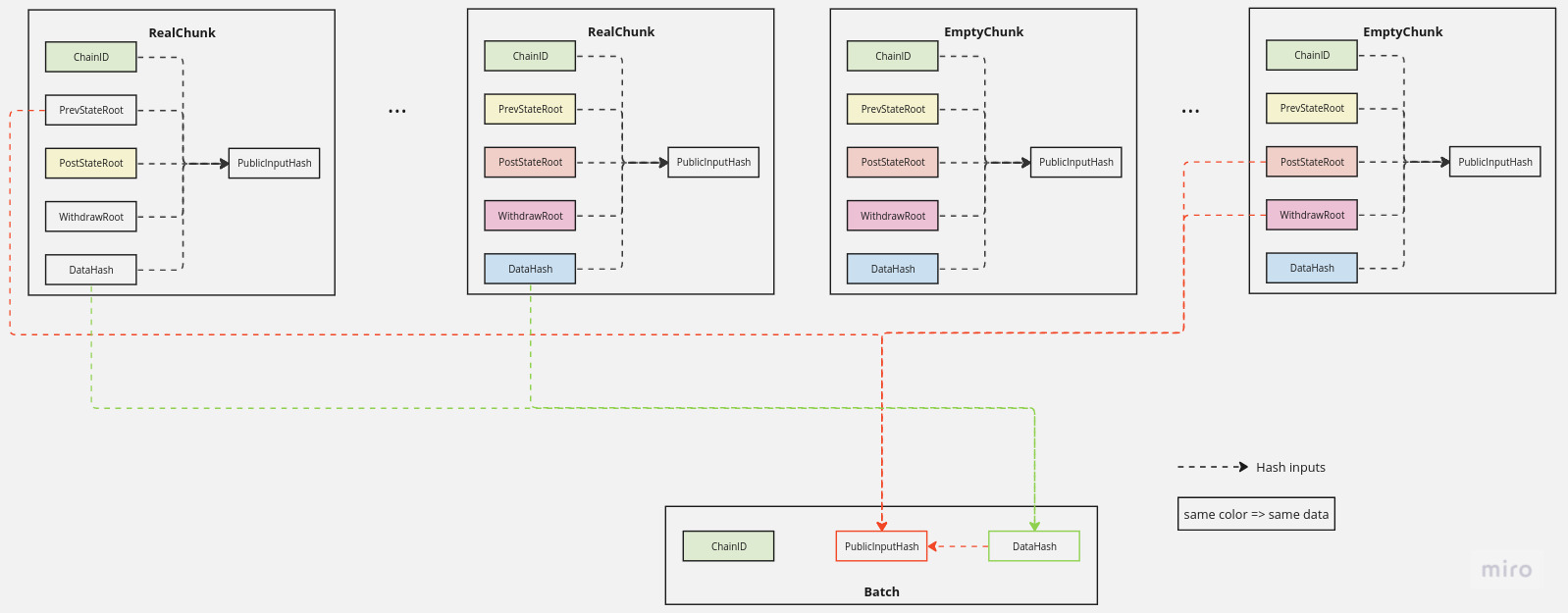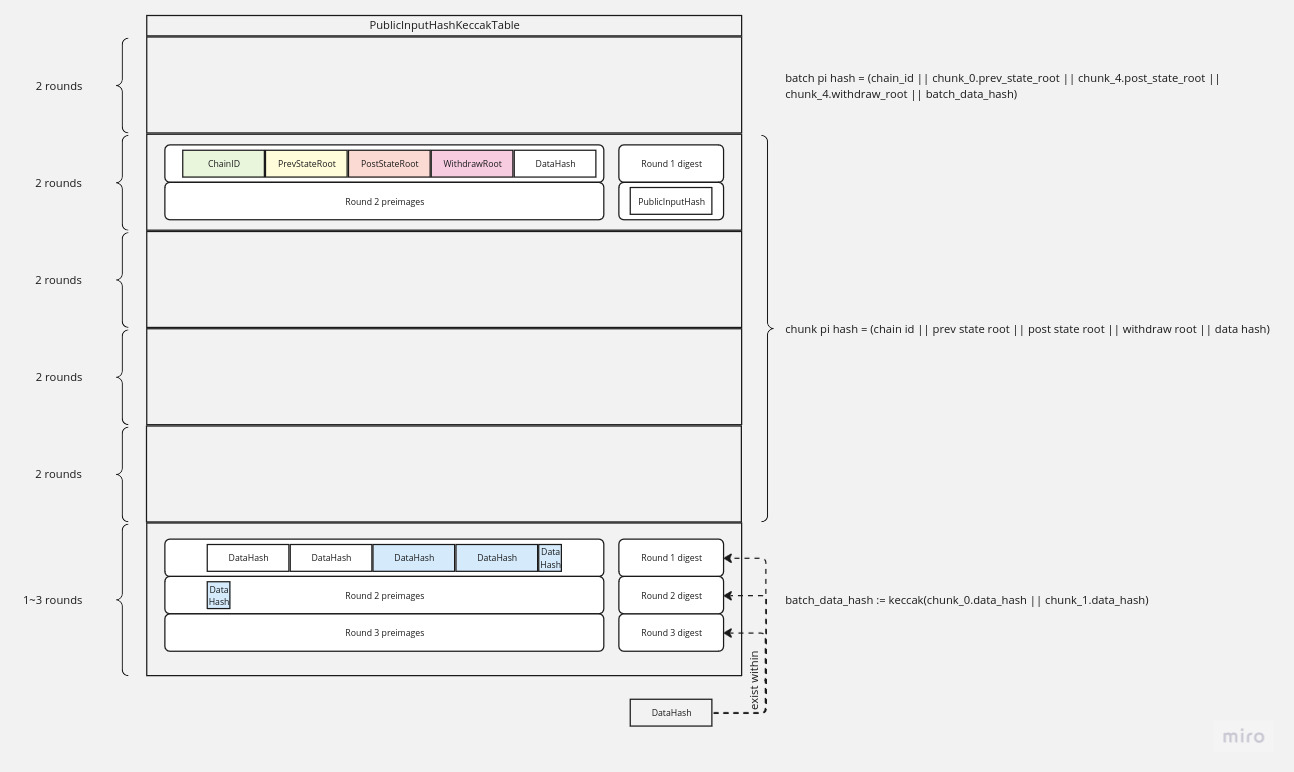| param | meaning |
|---|---|
| k | number of valid chunks |
| n | max number of chunks per batch |
| t | number of rounds for the final hash |
Currently n is hard coded to 10.
A chunk is a list of continuous blocks. It consists of 4 hashes:
- state root before this chunk
- state root after this chunk
- the withdraw root of this chunk
- the data hash of this chunk
Those 4 hashes are obtained from the caller.
The chunk's public input hash is
chunk_pi_hash := keccak(chain_id || prev_state_root || post_state_root || withdraw_root || chunk_data_hash)
A list of continuous chunks
c_i.post_state_root == c_{i+1}.prev_state_root
for
A padded chunk is a chunk that repeats the last valid chunk. It is used for padding.
If
- state root before this chunk:
c_{k}.prev_state_root - state root after this chunk:
c_{k}.post_state_root - the withdraw root of this chunk:
c_{k}.withdraw_root - the data hash of this chunk:
c_{k}.data_hash
A batch consists of continuous chunks of size k. If the input chunks' size k is less than n, we pad the input with (n-k) chunks identical to chunk[k].
Circuit proving the relationship for a chunk is indeed the zkEVM circuit. It will go through 2 layers of compression circuit, and becomes a snark struct. We do not list its details here. Abstractly, a snark circuit has the following properties:
- it takes 44 elements as public inputs
- 12 from accumulators
- 32 from public input hash
We want to aggregate k snarks, each from a valid chunk. We generate (n-k) padded chunks, and obtain a total of n snarks.
In the above example, we have k = 2 valid chunks, and 2 padded chunks.
The padded snarks are identical the the last valid snark, so the aggregator does not need to generate snarks for padded chunks.
There will be three configurations for Aggregation circuit.
- FpConfig; used for snark aggregation
- KeccakConfig: used to build keccak table
- RlcConfig: used to compute RLC of hash inputs
The public input of the aggregation circuit consists of
- 12 elements from accumulator
- 32 elements of
batch_pi_hash
For snarks
-
batch_data_hash digest is reused for public input hash. Static.
-
batch_pi_hash used same roots as chunk_pi_hash. Static.
batch_pi_hash := keccak(chain_id || chunk_1.prev_state_root || chunk_n.post_state_root || chunk_n.withdraw_root || batch_data_hash)
and batch_pi_hash matches public input.
- batch_data_hash and chunk[i].pi_hash use a same chunk[i].data_hash when chunk[i] is not padded
for i in 1 ... n
chunk_pi_hash := keccak(chain_id || prev_state_root || post_state_root || withdraw_root || chunk_data_hash)
This is done by computing the RLCs of chunk[i]'s data_hash for i=0..k, and then check the RLC matches the one from the keccak table.
- chunks are continuous when they are not padded: they are linked via the state roots.
for i in 1 ... k-1
c_i.post_state_root == c_{i+1}.prev_state_root
- All the chunks use the same chain id. Static.
for i in 1 ... n
batch.chain_id == chunk[i].chain_id
- The last
(n-k)chunk[i] are padding
for i in 1 ... n:
if is_padding:
chunk[i]'s chunk_pi_hash_rlc_cells == chunk[i-1].chunk_pi_hash_rlc_cells
This is done via comparing the data_rlc of chunk_{i-1} and chunk_{i}.
7. the hash input length is correct
- first MAX_AGG_SNARKS + 1 hashes all have 136 bytes input
- batch's data_hash length is 32 * number_of_valid_snarks
- batch data hash is correct w.r.t. its RLCs
- is_final_cells are set correctly
Our keccak table uses 300 rows. When the number of round is less than
The only hash that uses a dynamic number of rounds is the last hash.
Suppose we target for MAX_AGG_SNARK = 10. Then, the last hash function will take no more than 32 * 10 /136 = 3 rounds.
We also know in the circuit if a chunk is an empty one or not. This is given by a flag is_padding.
For the input of the final data hash
- we extract
32 * MAX_AGG_SNARKnumber of cells (static here) from the last hash. We then compute the RLC of those32 * MAX_AGG_SNARKwhen the correspondingis_paddingis not set. We constrain this RLC match thedata_rlcfrom the keccak table.
For the output of the final data hash
- we extract all three hash digest cells from the last 3 rounds. We then constraint that the actual data hash matches one of the three hash digest cells with proper flags defined as follows.
- if the num_of_valid_snarks <= 4, which only needs 1 keccak-f round. Therefore the batch's data hash (input, len, data_rlc, output_rlc) is in the first 300 keccak rows;
- else if the num_of_valid_snarks <= 8, which needs 2 keccak-f rounds. Therefore the batch's data hash (input, len, data_rlc, output_rlc) is in the 2nd 300 keccak rows;
- else the num_of_valid_snarks <= 12, which needs 3 keccak-f rounds. Therefore the batch's data hash (input, len, data_rlc, output_rlc) is in the 3rd 300 keccak rows;
| #valid snarks | offset of data hash | flags |
|---|---|---|
| 1,2,3,4 | 0 | 1, 0, 0 |
| 5,6,7,8 | 32 | 0, 1, 0 |
| 9,10 | 64 | 0, 0, 1 |
Additional checks for dummy chunk
- if
is_paddingfori-th chunk, we constrainchunk[i]'s chunk_pi_hash_rlc_cells == chunk[i-1].chunk_pi_hash_rlc_cells


